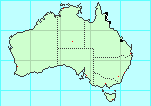Eggs have network of large cells on capsule. In the type species there are two large depressions, rather unusual in phasmid eggs. The conspicuous micropylar plate is depressed into the egg, hence its shape is not quite oval. A capitulum is present on a stalk. (From Brock, 2000.)
Identification Key
 Distribution
Distribution
The distribution map is a hot-linked index. By clicking
on a highlighted area of the map, you may obtain a species list for that
area, within this genus.
Etymology. - This Australian genus is named after its general resemblance to Carausius Stål 1875 (a genus originally named after a Roman Emperor).
References:
- Brock, P.D. (2000a). Studies on Australian stick-insects of the family Heteronemiidae, subfamily Lonchodinae, including the description of a new genus. Journal of Orthoptera Research, 9, Nov. 2000: pp. 51-55

